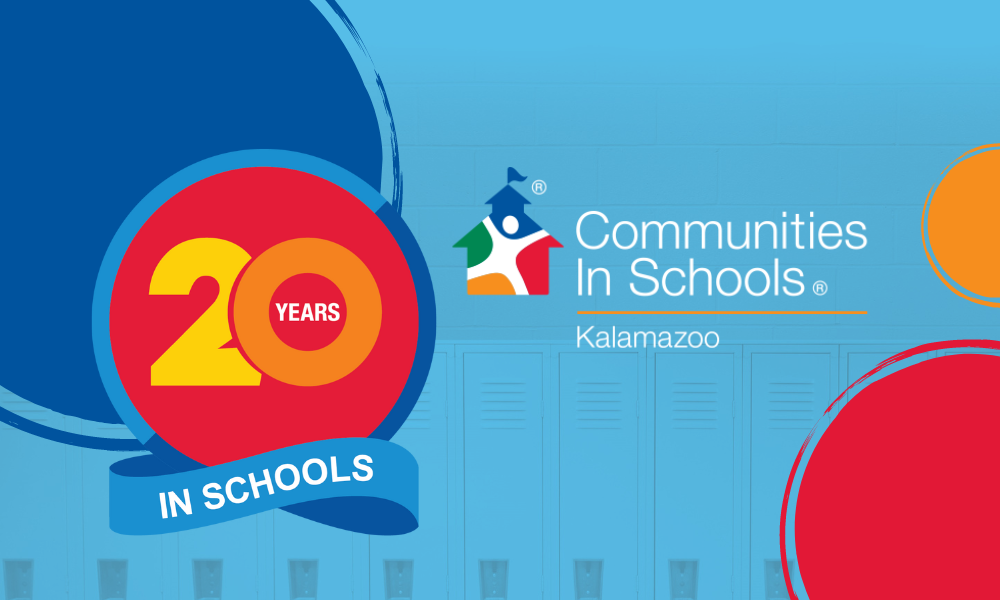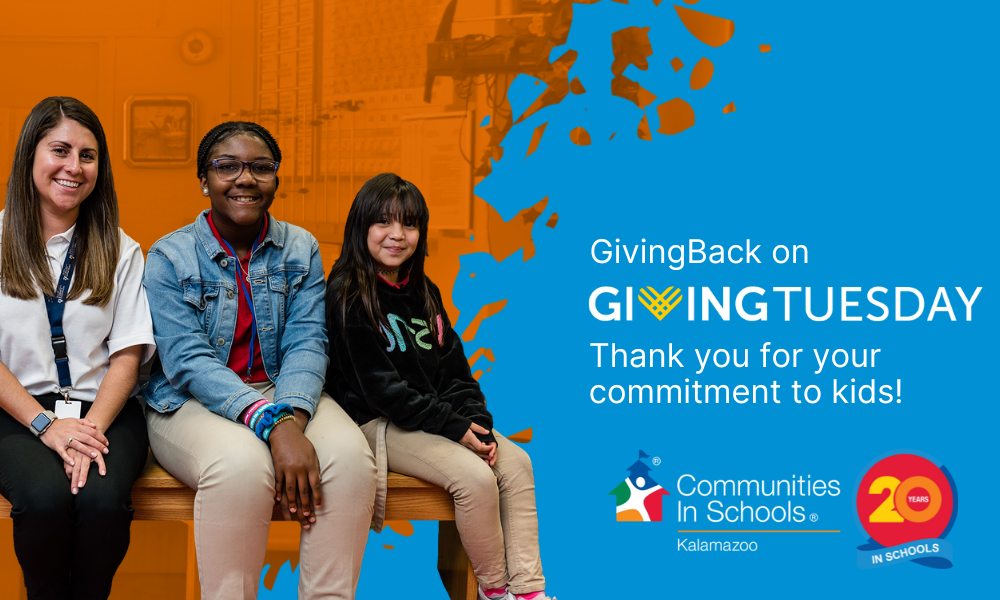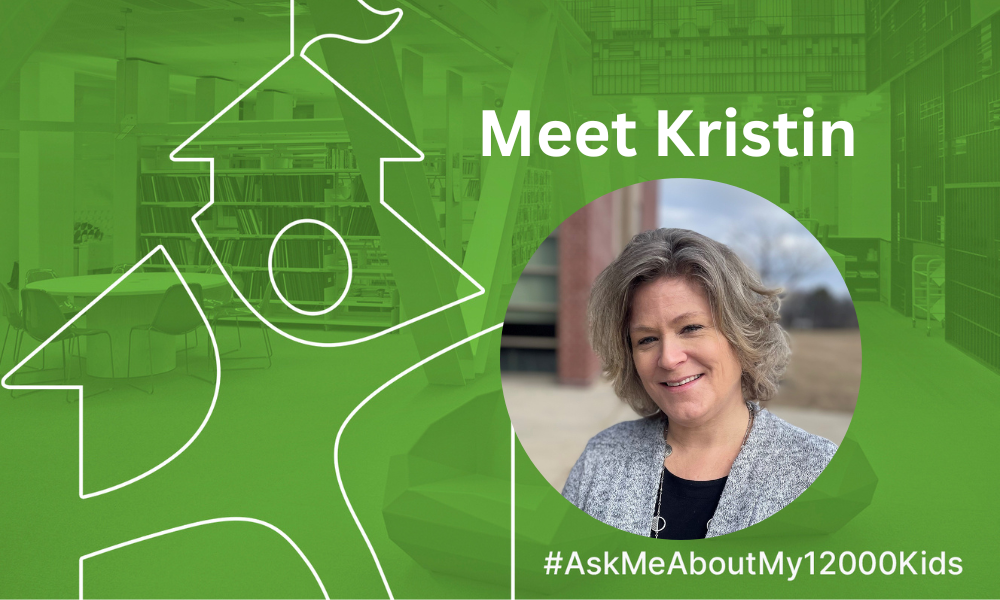Kristin Zimmerman: In Schools for Kids
Welcome back to the POP QUIZ! This is a regular, yet totally unexpected, feature where we ask students, parents, staff, our friends, and partners to answer a few questions about what they are learning, reading, and thinking about. Today we feature Kristin Zimmerman. Recently honored with a 2023 Champ Award, Kristin is a passionate therapist who is deeply committed to doing all she can to care for the mental health of students. [You can watch a short clip of this year’s Champ event here.]
Over the course of working almost ten years with CIS, Kristin has supported literally hundreds of students at Woodward School for Science and Technology, Northglade Montessori Magnet School, Milwood Elementary, Linden Grove Middle School, and Kalamazoo Central High School.
Kristin considers Kalamazoo her hometown as she has lived and worked in the area for nearly thirty years. Kristin graduated from Plainwell Public Schools and went on to earn both her bachelor’s and Master’s in Social Work from Western Michigan University. For the last eleven years, she has been doing private practice work through her business, Professional Counseling & Consultation Services.
Alright, Kristin: pencil out, eyes on your own paper. Good luck.
Pop Quiz
This year, you are working with over 20 students at Linden Grove. Describe what the work you do with CIS looks like on a given day or week.
Each school year, I am contracted with CIS to provide counseling/therapy to students one day a week for each school. I work closely with the site coordinator at each school as they provide me with the bulk of referrals for therapy and keep me informed on each student’s progress during the time I’m working with them. Each student is seen individually in a confidential space for a 45 to 60 minute session. where we work on mutually agreed upon goals specific to that student. And, depending on that student’s needs, I also may work closely with the school ounselors, social workers, teachers, and/or support staff. I’m also available to provide crisis management and referral and connection to community resources as needed.
A recent study (done by the U.S. Department of Health and Human Services and published in the American Medical Association’s journal JAMA Pediatrics) found that between 2016 and 2020, the number of children ages 3-17 years diagnosed with anxiety grew by 29 percent and those with depression by 27 percent. The findings also suggest concerning changes in child and family well-being after the onset of the pandemic.
In line with these sobering statistics, CIS site staff also tell us that they have been seeing an increased need for mental health supports, a reflection of what is happening throughout our nation. In your working with CIS and in your private practice are you also seeing that increased need for mental health services? And if so, are you noticing any trends? Any shifts in the types of mental health challenges that our youth and/or their families are facing?
That study began in 2016, about four years before pandemic. One thing I will say—and this is based on my discussions with those I collaborate with out at Linden Grove, from the CIS staff, to KPS administrators, staff and teachers—is that we have become, within our society, much more accepting of talking about mental health and much more aware. The proliferation of the internet coupled with the onset of the pandemic really forced us to rely on the internet and social media for everything, most notably socialization and education. I think adolescents may find it safer and/or easier to address their mental health struggles on internet platform rather than seeking out help in person. In response to the need for virtual learning, and the continued reliance on technology for education even when in person, the schools had to develop systems to monitor the behavior of the students virtually. One thing that has come out of that is the identification of more students with mental health concerns. So I think that the increased and efficient monitoring, as well as the increased acceptance of discussing and obtaining help for mental health issues has contributed equally to the increase in referrals for cousneling.
I have seen more adolescents and young adults referred to me through CIS and through my practice in general for mood-related issues such as anxiety, depression, and trauma. There is a lot in society for students/teens to be anxious about now; however, the mental health issues have been there all along.
So you’re saying, mental health needs have been there all along and just maybe the pandemic has brought it to the forefront.
Yes. I will say that the kids coming into services have, until recently, presented with much more intense needs in terms of mental health issues. However; it’s hard to say if it has had been there all along but we just hadn’t really looked at it … I do think we are doing a better job of monitoring and catching them. The internet and social media have done great things for us during the pandemic and they have also made the realities of our current affairs (a pandemic and school shootings to name just a few) inescapable for kids. Children and adolescents are still developing and thus aren’t equipped with the coping skills of an adult. This contributes to their increased vulnerability to mental health problems. When thinking about the results of the (above-mentioned) study, I guess I would say that a multitude of factors are contributing to the rise in anxiety and depression in our country. These would include the normalization of discussing and receiving help for mental health issues, the increased reliance and time spent on the internet for socialization, the increased monitoring and follow up by school staff, the amount of information regarding identifying, diagnosis and treating mental health concerns as well as the destigmatization of it, the increase in academic pressures placed on students, and the constant inundation of societal issues outside of an adolescent’s ability to manage it all.
I can’t say enough good stuff about KPS and schools like Linden Grove. They are on it! I’ve had cases where I’ve worried about a particular child and I go the site coordinator and we work together. And then the principal and vice principal and teacher, and sometimes along with additional agencies, we are all working together to support this child. It’s like a well-oiled machine. The way that Communities In Schools and KPS works together really makes a difference.
That’s great to hear!
Back to that study, the research also highlights that it’s essential to support both children and their caregivers if we want to improve families’ mental and well-being which, they point out, includes ensuring access to timely health care services. That sounds so obvious, but it is so important. That is what you do, and your willingness to work within the school setting so kids can get services where they are, when they need them really impacts their well-being in a positive way.
I can say that after doing this for ten years that every site coordinator has known how to get those kids in and is able to work well with me and the school at coordinating, triaging students, and brainstorming. It really is a good partnership and I’ve had such a positive experience with everyone.
Well, our site folks say the same about you when it comes to partnering with you over the years. You are touching base with them about kids, they can pick your brain and that your advice and insight really benefits our kids as well as their own personal growth.
What did your work look like when the students you had been serving where no longer in the buildings and were doing school virtually? How did that work?
I was at Kalamazoo Central and Linden Grove at the start of the pandemic and in the fall of 2021, still saw them. It was hard because the kids were on virtual, but site coordinators were out there all the time, going to families’ homes, knocking on their doors to check on them, making sure they had food and letting me know what is going on. There were times that we would go out together to a student’s home if there was a crisis. Also, the site coordinators would bring me the necessary paperwork to my house to sign because we couldn’t go to the school buildings. And then I would see the kids virtually, though sometimes, some of the kids didn’t want their screens on. I’d push them not to do that, but sometimes it was like, okay, at least you are here.
What do you think that was about?
I don’t really know, though I think multiple factors were involved. One, that there were things or things going on in their home that they just didn’t want people to see. Some had a hard time not losing a chrome book, their brother or sister took it, some were moving often, or their Wi-Fi got shut off. And during all that, I saw CIS going above and beyond to reach these kids and their families and not let them go.
Some parents brought their children to my office because they wanted their child to have that in-person connection. We all tried to be as accommodating as we could and were all working together to catch these kids and hold them in a safe space, so to speak, until schools reopened.
How do you see CIS supporting the critical work you are doing to address student’s mental health needs?
I think CIS is the backbone of what I do in the schools. If I didn’t have site coordinators and didn’t benefit from the relationships they have with the schools and with the resources, I wouldn’t be connected to the kids that need my support the most. The site coordinators serve as those eyes and ears we need to do this work well and meet students’ needs.
Teachers can’t see everything and the site coordinators are the eyes and ears and taking a look at all the needs the kids may have, be it home, family life, shelter, medical and make sure those needs get met. That’s crucial. If we don’t have those basic needs met for the kids we serve, we can’t do therapy. CIS is the backbone for all of that.
Without CIS, it would be a lot harder to go into the schools. Years ago, I used to do that when I did home-based counseling, but it was harder … CIS helps bridge the gap and by serving as that go-between between the school and the therapist, well that adds a level of safety as they are working withing the school to streamline those who are coming into the school.
What are you currently reading?
Faithful by Alice Hoffman.
What is a question you recently asked or perhaps have been asking a lot lately?
I’ve often asked myself this question, but I’m finding myself asking it more in the past few years: Am I helping? Am I doing enough? I think maybe a lot of clinicians out there are asking these same type of questions. Many of us are pretty exhausted from this pandemic. You want to see and help everybody. It’s just been hard with the influx of clients since 2020. Sometimes I forget how hard it is and that’s because we’re all living in it, but then, when I step back and can see through kids’ eyes, see their perspective, and recognize what they are going through, that really helps put things in perspective for me. …The students, they’ve taught me more than I’ve given them.
So when you aren’t supporting students through CIS and aren’t seeing clients in your own private practice, what do you enjoy doing in your “free time?”
I love reading. I read books and lots of magazines such as The New Yorker. I enjoy skiing, taking walks with my dog, and spending time with my children who are 16 and 18. They keep me very busy! Right now, my 16 year-old is learning how to drive.
Thank you, Kristin, for hanging out with us at Ask Me About My 12,000 Kids.
Tags: Champs, CIS, Communities In Schools of Kalamazoo, Kalamazoo Public Schools, Kristin Zimmerman, Linden Grove Middle School, mental health, Social Work, Western Michigan University, Woodward




